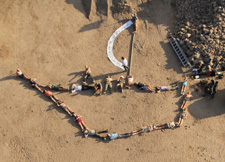As Passover Approaches, Pharaoh Sends His Greetings

Scarab, Reg. Number 15D2-0001; Image p15X-1004
A rare scarab seal belonging to a senior Egyptian official of the Thirteenth Pharaonic Dynasty (the 18th-17th centuries BCE) has been found at Tel Dor on Israel's Carmel Coast. The seal was discovered by Alexander Ternopolsky, a birdwatcher, who handed it over to the archeological team working at the site. "The scarab must have belonged to a very senior figure in the kingdom, probably the viceroy responsible for the royal treasury," explains Prof. Ayelet Gilboa from the Department of Archeology at the University of Haifa, who is heading the excavations at Tel Dor together with Prof. Ilan Sharon from the Hebrew University in Jerusalem. "The owner of this scarab filled a similar position to that held by Joseph in Egypt after he interpreted Pharaoh's dreams."
The coastal city of Dor, at the foot of Mt. Carmel, was a key port city for thousands of years. Until the Romans built Caesarea, Dor was the most important commercial center in the area and served as a hub for commercial and passenger traffic throughout extensive periods in human history. The city is mentioned in Egyptian inscriptions dating back 3500 years, and even in the Books of Joshua, Judges, and I Kings in the Bible.
Excavations began at Tel Dor in the mid-twentieth century and have been directed since 2002 by Prof. Gilboa and Prof. Sharon. Findings include settlements from the Late Bronze Age (the Canaanite period in the second millennium BCE), as well as a Phoenician settlement and Israelite and Assyrian administrative centers (Iron Age); a city and palace from the Hellenistic period, including a splendid mosaic; and monumental remains from the Roman period, including a pair of temples that may have been dedicated to Poseidon, the god of the sea. "We have not yet reached the settlement of the 17th century BCE," Prof. Gilboa explains, "and this is why this finding is particularly important. The rains this past winter must have eroded the soil on the southern slope of the site, and thanks to Mr. Ternopolsky's keen eyesight, the scarab was discovered and handed over to us."
A preliminary study showed that the stone scarab is engraved with the name of its owner, as well as his position and ankh symbols (crosses with a looped head), which symbolized eternal life, and pillar-like djed symbols that emblemized resurrection and stability. The description of the scarab owner's position includes such phrases as "overseer the treasury," "bearer of the seal," and more, but the owner's name has not yet been deciphered. "Scarabs were very common objects in ancient Egypt, but the size and quality of this one, its owner's high-ranking position, and the gold ring in which it is set all make this particular scarab a rare finding in our region," Prof. Gilboa explains.
The excavators suggest two possible scenarios for the manner the scarab might have reached Dor. The first is that a representative of the viceroy may have come to this important trading city, which was a supply base for spices, resin, and other commodities that were highly valued by the Egyptians, in order to seal a deal for his superior. Accordingly, he would have brought the viceroy's seal with him (or perhaps even the viceroy himself made the visit). The second possibility is that the scarab arrived at Dor at a much later stage, perhaps even during the Roman period, when there was demand for such "antiques." Prof. Gilboa adds: "Since the scarab rolled down from the mound and was not found in its archeological context, we will probably never really know when and how it got here and where it has been."
The excavations at Tel Dor will resume this coming July. Anyone who is interested is invited to join. This fascinating scarab is displayed at the Mizgaga Museum in Kibbutz Nahsholim, alongside many other finds from Dor.

